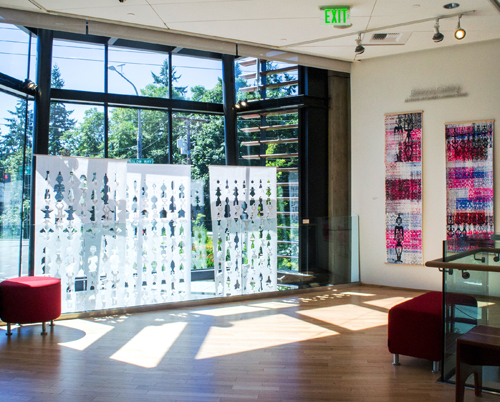By Vivian Nguyen
Northwest Asian Weekly

“No More Suffering,” Paper cut (Photo by Renate Raymond)
“I always knew.”<!–more–>
This was Roman Bustillo’s response when he realized that he wanted to be an artist.
Bustillo was born and raised in Cagayan, Philippines. As a child, Bustillo was exposed to art consistently and often from a young age. Art became a part of how he internalized his everyday life.
His mother, who was a musician and fabric maker, helped influence Bustillo’s exposure to textiles and aesthetics. He developed an appreciation for the colorful tapestries, carvings, and artwork created by the indigenous people in his region.
“My physical environment has always influenced my work,” said Bustillo. “Culture has always shaped how and why I view my art, and it’s distinctly attached to the environment I am in.”
In 1978, Bustillo and his family immigrated to America and settled in the Seattle area. He grew up in Columbia City, where his physical and cultural environment once again influenced his work. Northwest artists, as well as the Asian American culture of Seattle, continued to mold and influence Bustillo’s work.
Over time, Bustillo also became involved with Seattle’s local art community, which helped him foster mentoring connections, and gave him a space to connect with other like-minded artists. This sense of community, coupled with Bustillo’s artistic influence from culture and places, normalized his everyday surroundings as a source of artistic inspiration.
On thought and work processes
“Like many artists, I’m like a sponge,” said Bustillo, on how he thinks about and absorbs his inspiration and work.
Cultivating new artistic concepts and pieces requires extensive time spent in his studio, where he often settles in when he needs the space to interpret and execute his ideas.
Places beyond the Philippines and the Pacific Northwest have also influenced him. Bustillo’s travels have taken him across Southeast Asia, Europe, and South America, where he’s been fascinated by the use of “ikat” across these continents.
Ikat plays a strong role in Bustillo’s art. Originally known as a Malaysian word, ikat has become the universal description for a type of weaving that involves “resist dying.” “You have a string or thread, you tie it, and then you soak it in dye. When you reveal the work after the dyeing process, it reveals the images and woven patterns,” explained Bustillo about the ikat-making process.
Bustillo is fascinated by the use of ikat across continents and cultures, and how the style can be contextualized and translated for and across different cultures. Although Bustillo doesn’t weave, he’s intrigued by ikat because of its universal meaning, the process behind it, and the end result.
“I’m not focused on whether or not it’s beautiful,” said Bustillo about a finished ikat. “What I focus on is the meaning behind it.”
An ikat will often be made with very specific cultural and religious meaning, which will be identified by certain colors or weaving patterns used.
However, Bustillo believes that each ikat’s meaning could be open to interpretation, despite the original intent behind its creation. “The artist is imposing an idea on the viewer, and creating a piece with a certain message in mind, but the viewer doesn’t actually have to agree with it,” said Bustillo. “I don’t expect that.”
“As a contemporary artist, you have a position about your art, but the public also has a specific opinion on it. The thing contemporary artists forget is that viewers could and should reinterpret the art — your work — into their own context. They’re reinterpreting my art from the bank of knowledge that they know.”
“Dugay na”: The Exhibition
Bustillo’s current exhibition, titled “Dugay na,” is on display at the Bainbridge Island Museum of Art (BIMA) on Bainbridge Island. The exhibit runs through Sept. 24. There are 30 pieces on presentation in this installation.
“Dugay na” is a phrase in Mindanao Bisaya, a Filipino dialect, which translates to “no longer new” or “a long time now.” Bustillo employs “dugay na” to convey long periods of time in relation to his work and life, such as the ancient art of ikat itself to more personal references like his lengthy career as an artist.
“[The exhibition] references my Filipino cultural heritage, my background in Seattle, and my travels throughout Guatemala and Spain,” said Bustillo.
While Bustillo’s pieces in “Dugay na” do not use fabric as traditionally found in ikats, he employs similar patterns in the process. Using paper and scissors, Bustillo creates serigraphs that follow ikat prints as a point of reference. Serigraphs, or screen printing, is a fine art silk screen process that Bustillo favors. The serigraphs are hung throughout the exhibition.
Other pieces, such as one titled “No More Suffering” that hangs in the Beacon Gallery of BIMA, is a white paper cut piece, using patterns found in ikat. Its position by a glass window allows it to rely on light to affect the piece and the viewer, creating a light exhibition.
Moving forward, Bustillo hopes to continue evolving as an artist through continued teaching, mentorship, and study.
“I want to be surprised by where and how it evolves,” said Bustillo about his art. “I want to continue to interpret art across cultures. And I want ikat to continue contributing to what I do. I see it as being a part of me.” (end)
Romson Bustillo’s “Dugay na” runs at the Bainbridge Island Museum of Art through Sept. 24. For more information, visit www.biartmuseum.org.
Vivian Nguyen can be reached at info@nwasianweekly.com.



